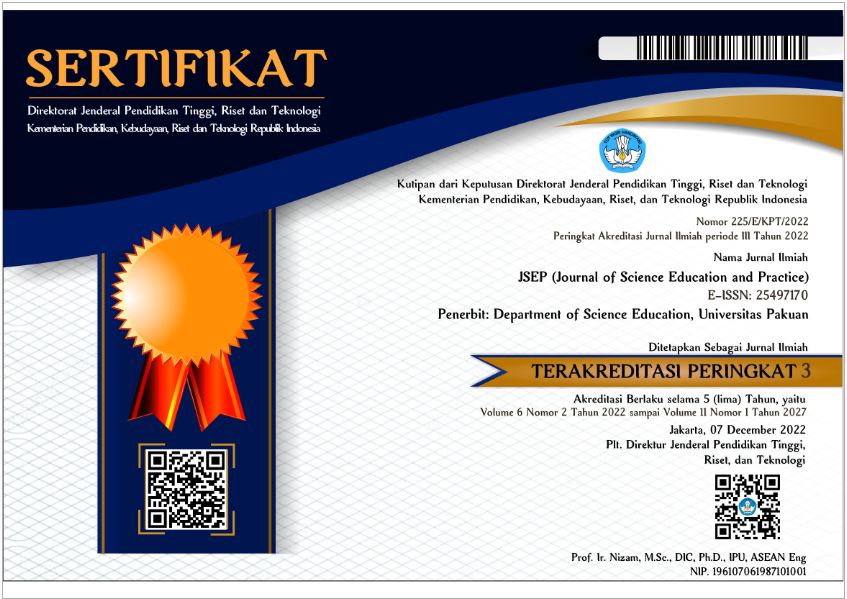ADDITIONAL MENU
Electronic Student Worksheets to Train Scientific Literacy in Chemical Equilibrium Material
Abstract
Keywords
References
Afrita Guru SMP Negeri, L. (2021). Penerapan Model Pembelajaran Matery Learning dalam meningkatkan Hasil Belajar IPA pada Peserta Didik Kelas IX.3 SMP NEGERI 32 Palembang. Jurnal Edukasi, 7, 60-72.
Agustina, R., Sibarani, M., & Afandi, A. (2019). Pentingnya Literasi Sains bagi Siswa di Era Revolusi Industri 4.0 Developing High Order Thinking Stimulation Model for Pre-Service Teachers’ Science Education View project. Retrieved from https://www.researchgate.net/publication/343859499
Ait, K., Rannikmäe, M., Soobard, R., Reiska, P., & Holbrook, J. (2015). Students Self-Efficacy and Values Based on A 21st Century Vision of Scientific Literacy – A Pilot Study. Journal of Procedia - Social and Behavioral Sciences, 177, 491–495. https://doi.org/10.1016/j.sbspro.2015.02.403
Akker, J. J. H. van den (Jan J. H., Plomp, Tj. (Tjeerd), Bannan, B., Cobb, Paul., Folmer, Elvira., Gravemeijer, K. (Koeno P. E., Kelly, A. E., Nieveen, N. M., & SLO (2000- ). (2013). Educational design research / Part A: an introduction. Netherlands: Netherlands institute for curriculum development.
Belfali, Y. (2019). PISA 2018 Results Programme for International Student Assessment What is PISA? Indonesia. Jakarta : Head of Early Childhood and Schools.
Cholifah, S. N., & Novita, D. (2022). Pengembangan E-LKPD Guided Inquiry-Liveworksheet untuk Meningkatkan Literasi Sains pada Submateri Faktor Laju Reaksi. Chemistry Education Practice, 5(1), 23–34. https://doi.org/10.29303/cep.v5i1.3280
Daniah Daniah. (2020). Pentingnya Inkuiri Ilmiah Pada Praktikum dalam Pembelajaran IPA untuk Peningkatan Literasi Sains Mahasiswa. Jurnal Pendidikan, 9(1). https://doi.org/10.22373/pjp.v9i1.7178
Fuada, S., & Fajriati, N. F. (2021). Pelatihan pembuatan modul interaktif menggunakan aplikasi Liveworksheet bagi guru di SDN Wiwitan Bandung. Community Empowerment, 6(11), 2010–2021. https://doi.org/10.31603/ce.5499
Fujiati, H., Hartono, R., & Fitriati, W. (2020). The Implementation of Curriculum 2013 in Teaching Speaking Skill At MAN 2 Bima. Retrieved from http://journal.unnes.ac.id/sju/index.php/eej
Fuzi, P., Dan, A., & Dwiningsih, K. (2018). Pengembangan Lembar Kegiatan Siswa Beroriengtasi Literasi Sains pada Materi Ikatan Kimia. Journal of Chemical Education, 7 (3), 358-364.
Gunawan, R. M., Rubini, B., & Permana, I. (2022). Development of Learning Web to Improve Junior High School Students’ Scientific Literacy. Journal of Science Education and Practice (JSEP), 6 (2), 119-128.
Hake, R. R. (1999). Analyzing Change/Gain Scores. Woodland Hills: Dept. of Physics, Indiana University.
Hake, R. R. (1998). Interactive-engagement versus traditional methods: A six-thousand-student survey of mechanics test data for introductory physics courses. Department of Physics, Indana University, American Journal of Physics, 66(1), 64–74. https://doi.org/10.1119/1.18809
Indriani, A., Bagus Suryadharma, I., C1, Y., & Kimia, J. (2017). Identifikasi Kesulitan Peserta Didik dalam memahami Kesetimbangan Kimia. Journal of Pembelajaran Kimia OJS, 2 (1), 9-13.
Kemendikbud. (2018). Permendikbud Nomor 34 Tahun 2018 Tentang Standar Nasional Pendidikan Menengah Kejuruan/Madrasah Aliyah Kejuruan Standar Penilaian Pendidikan. Jakarta: Mendikbud.
Kemendikbud. (2020). Capaian Pembelajaran Mata Pelajaran Kimia Fase E-Fase F Untuk SMA/MA/Pogram Paket C 2. Jakarta: Mendikbud.
Klucevsek, K. (2017). The intersection of information and science literacy. Communications in Information Literacy, 11(2), 354–365. https://doi.org/10.15760/comminfolit.2017.11.2.7
Mukhadis, A. (2013). Sosok Manusia Indonesia Unggul dan Berkarakter Dalam Bidang Teknologi Sebagai Tuntutan Hidup di Era Globalisasi. Journal of Pendidikan Karakter, 4 (2), 115-136. https://dx.doi.org/10.21831/jpk.v2i2.1434
OECD. (2016). PISA 2015 Results Excellence and Equity in Education. Paris: OECD Publishing.
Pratiwi, S. N., Cari, C., & Aminah, N. S. (2019). Pembelajaran IPA Abad 21 dengan Literasi Sains Siswa. Journal of Materi dan Pembelajaran Fisika (JMPF), 9, 34-42
Retnowati, R., Permana, I., & Rončević, T. (2022). Webbed Type of Integrated Science Learning on the Theme of Environmental Pollution to Improve Students’ Scientific Literacy. Journal of Science Education and Practice (JSEP), 6 (2), 77-94.
Ridwan. (2015). Metode Riset Metodologi Penelitian. Alfabeta.
Sari, I. F., & Iswendi, I. (2023). The Effectiveness of using Android Based Chemical Ludo Game Media Reduction and Oxidation Reaction Material on Students Learning Outcomes. Prisma Sains : Jurnal Pengkajian Ilmu Dan Pembelajaran Matematika Dan IPA IKIP Mataram, 11(2), 267-280. https://doi.org/10.33394/j-ps.v11i2.7474
Schwab, K. (2015). The Global Competitiveness 2015-2016., World Economy Forum. Columbia: Columbia University.
Sugiyono, P. D. (2016). Metode Penelitian Pendidikan. Bandung: Alfabeta.
Utomo, A. P., Hasanah, L., Hariyadi, S., Narulita, E., Suratno, &
Umamah, N. (2020). The effectiveness of steam-based biotechnology module equipped with flash animation for biology learning in high school. International Journal of Instruction, 13(2), 463–476. https://doi.org/10.29333/iji.2020.13232a
Wright, K. L., Franks, A. D., Kuo, L. J., McTigue, E. M., & Serrano, J. (2016). Both Theory and Practice: Science Literacy Instruction and Theories of Reading. International Journal of Science and Mathematics Education, 14(7), 1275–1292. https://doi.org/10.1007/s10763-015-9661-2
Yanni, M. L., Azizah, U., Kunci, K., Lks, :, & Kimia, K. (2018). Pengembangan Lembar Kegiatan Siswa (LKS) Berbasis Literasi sains pada Materi Kesetimbangan Kimia Kelas. Unesa Journal of Chemical Education, 7, 308-314.
Yusuf Hidayat, M., Nenyhindarwaty, A. A., & Nur, F. (2020). Analisis Penentuan Standar Nilai Kriteria Ketuntasan Miniaml (KKM) Mata Pelajaran Fisika Kelas XI SMAN 17 Makassar. Jurnal Pendidikan Fisika, 8. Retrieved from http://journal.uin-alauddin.ac.id/indeks.php/PendidikanFisika
DOI: 10.33751/jsep.v7i1.7766
 Abstract views : 381
Abstract views : 381
Refbacks
- There are currently no refbacks.
Copyright (c) 2023 JSEP (Journal of Science Education and Practice)

This work is licensed under a Creative Commons Attribution 4.0 International License.












